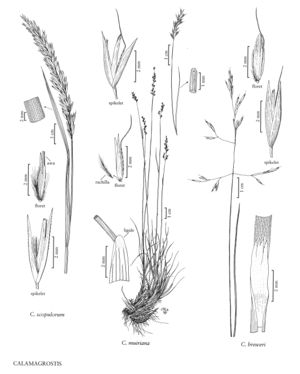Calamagrostis muiriana
Plants sometimes with sterile culms; densely cespitose, often with rhizomes 1-3 cm long, 1-2 mm thick. Culms (10) 12-35 cm, unbranched, smooth beneath the panicles; nodes 1-3. Leaves basally concentrated; sheaths and collars smooth or scabrous; ligules 1-2.5 mm, obtuse, entire to lacerate; blades (1) 4-12 cm long, 0.2-0.4 mm in diameter, involute, abaxial surfaces scabrous, adaxial surfaces sparsely hairy. Panicles (1.5) 1.9-5.7 (7.5) cm long, 0.4-3 cm wide, contracted to open, usually dark purple, rarely straw-colored; branches (0.8) 1.1-2 (3.5) cm, smooth, spikelets usually confined to the ends of the branches. Spikelets (3) 3.5-4.5 (5) mm; rachilla prolongations about 2 mm, hairs 0.5-1 mm. Glumes rounded, midvein smooth or slightly scabrous, lateral-veins obscure, apices acute to acuminate, rarely awn-tipped; callus hairs (0.2) 0.3-0.6 mm, 0.1-0.2 times as long as the lemmas, sparse; lemmas (2.5) 3-4 mm, 0.5-1 mm shorter than the glumes; awns 3.5-6 mm, attached to the lower 1/3 of the lemmas, exserted, bent, purple; anthers 0.9-2.5 mm. 2n = 28.
Discussion
Calamagrostis muiriana grows in moist to dry, subalpine and alpine floodplain meadows, lake margins, and stream banks, at 2400-3900 m, in the Sierra Nevadas south of Sonora Pass in central California. It differs from C. bolanderi (p. 719) in having basally concentrated leaves.
Selected References
None.
Lower Taxa
"decumbent" is not a number.
